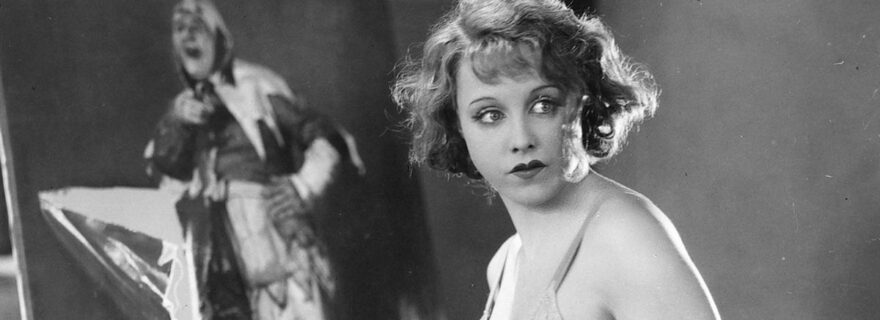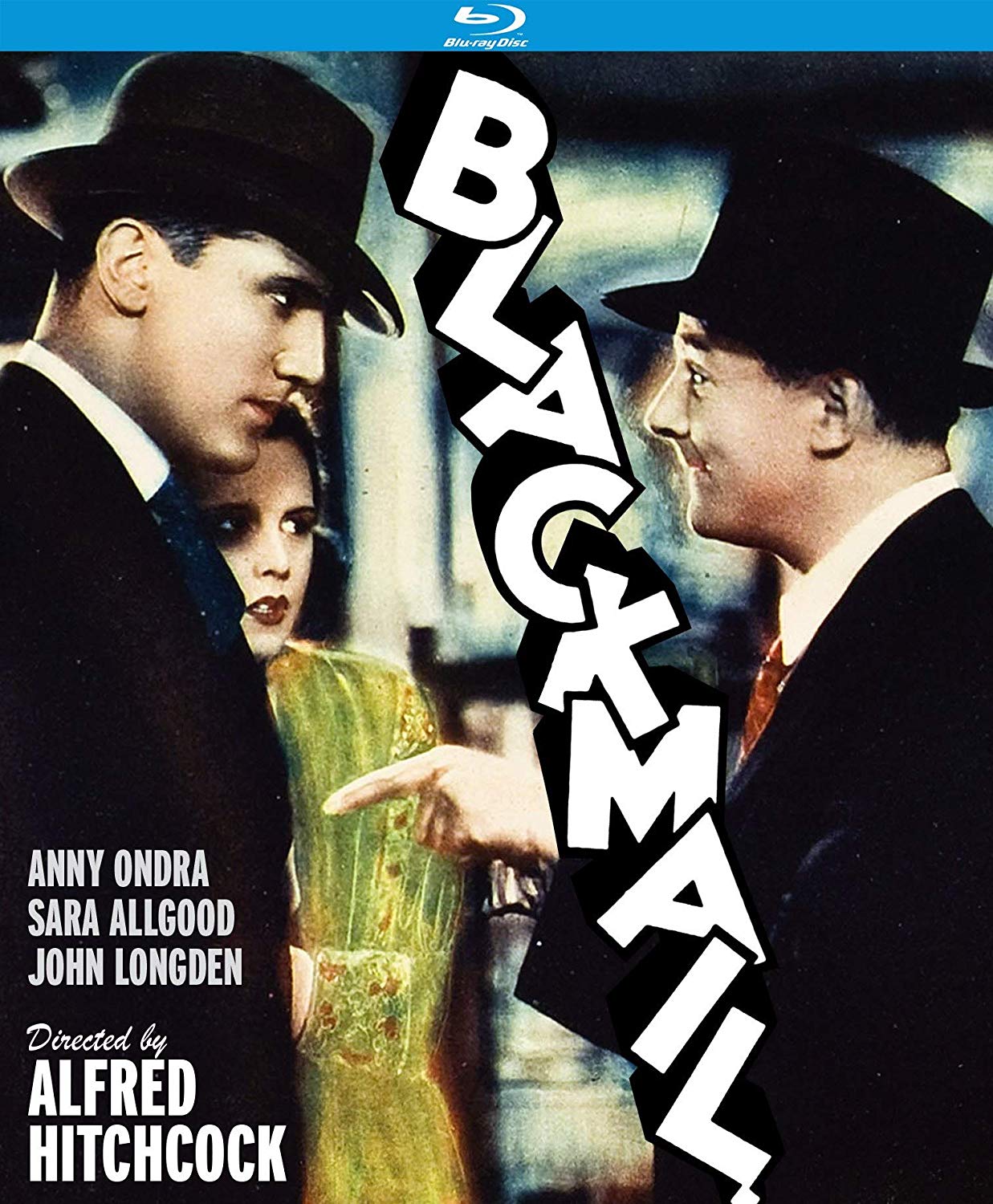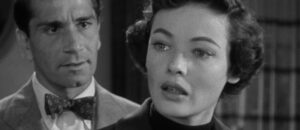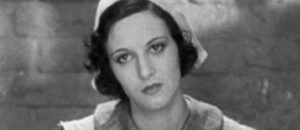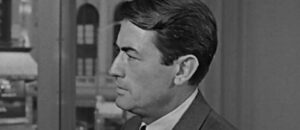Blackmail proved that there could be a lot more to “talking pictures” than just talk. Alfred Hitchcock’s first sound film used the new technology in exciting and innovative ways, and as a result, this captivating thriller still impresses on many levels 90 years later.
Blackmail
Theatrical Release Date: July 28, 1929
Blu-ray Release Date: August 13, 2019
Directed by: Alfred Hitchcock
Starring: Anny Ondra, John Longden, Sara Allgood, Cyril Ritchard
Blu-ray Special Features: Silent version, introduction, audio commentary, audio interviews, sound test, trailer
Blackmail is a landmark film. Not only is this textured, engrossing Alfred Hitchcock thriller the very first all-talking British movie, it also uses the primitive medium of sound in creative and unusual ways. Unlike most directors of the period, Hitchcock wasn’t content to go through the motions and make a pedestrian film that would merely exploit the novelty of sound and pander to audiences and executives who craved “talking pictures.” He went all in, embracing the technology, showcasing its potential, and ultimately proving that sound was much more than a flash-in-the-pan fad. Before Blackmail, the microphone was just a tool to record dialogue, live music, and rudimentary effects. But with this classic exercise in suspense, Hitchcock showed the world what a powerful, versatile filmmaking instrument it could be, and that sound would soon become just as vital an element in a movie’s construction as the camera.
Blackmail was originally conceived – and ultimately exhibited in many areas – as a silent film, but as the phenomenon of sound began to capture the public’s imagination, studios worldwide scrambled to capitalize on the craze. Hitchcock saw the writing on the wall and was well prepared when, midway through production, his bosses demanded a talking version of Blackmail (even though only a few London theaters at the time were equipped to screen sound movies). Although many scenes were already in the can, Hitchcock had cleverly composed them so that sound and dialogue could be seamlessly added later, thus minimizing the need for retakes. For instance, by filming the actors from behind so we don’t see their mouths, conversations could be subsequently recorded over the action. While Hitchcock did revamp several sequences (the sound version ends up running about ten minutes longer than the silent version) and even recast one minor role, the modifications he made to facilitate the use of sound are strikingly minor.
Based on a successful stage play by Charles Bennett (who would script a host of future Hitchcock classics including The Man Who Knew Too Much, The 39 Steps, Sabotage, Secret Agent, Young and Innocent, and Foreign Correspondent, for which he received an Oscar nomination), Blackmail tells a simple but very effective cat-and-mouse yarn that focuses more on moral dilemmas than the violent act that spawns them. Alice White (Anny Ondra), an attractive, somewhat frivolous young woman (and the first in a decades-long string of iconic Hitchcock blondes), is in a tempestuous relationship with Scotland Yard detective Frank Webber (John Longden). Tired of playing second fiddle to the police department and not getting the attention from Frank she thinks she deserves, Alice encourages a dapper artist named Crewe (Cyril Ritchard) to ask her out. What begins as a mild flirtation, however, soon turns deadly when Crewe tries to rape Alice in his studio. After an intense struggle, Alice stabs Crewe in self-defense, but leaves her gloves at the scene. Tracy (Donald Calthrop), a slimy blackmailer who’s been mysteriously dogging Crewe, discovers one of them, while Frank, who’s assigned to the case the next morning, finds its mate. Tortured by her conscience and traumatized by the event, Alice soon finds herself caught between an extortionist and her policeman boyfriend, who wants to suppress the bombshell evidence that might convict her.
Patented Hitchcock themes like fear of the police, paranoia, psychological gamesmanship, and an innocent man accused of a crime he did not commit permeate the drama. Stunningly, the 90-year-old Blackmail really hits home – and connects with 21st Century audiences – by presenting a situation that easily could have been ripped from the headlines in our current #MeToo era. Everything about Alice’s ordeal nine decades ago disturbingly mirrors stories we’ve heard from victimized women in our current culture.
Does this sound familiar? Alice goes on a date with a good-looking, seemingly innocuous fellow who turns out to be a sexual predator. He lures her into his apartment, relaxes her with flattery, plies her with alcohol, coaxes her into trying on a slinky tutu, then – after she rejects his advances – tries to sexually assault her. After she kills him in self-defense, Alice falls into a catatonic state of shock and blames herself for what happened. Acute shame and embarrassment consume her and keep her from telling anyone, including her parents and especially her policeman boyfriend, about the incident. She even feels that she should be punished for her “crime,” even though she did nothing to provoke the attack. In the blink of an eye – and like so many women we’ve heard and read about over the past few years – the life of a carefree, vivacious girl is shattered, and the psychological wounds inflicted upon her likely will never heal. Hitchcock builds plenty of tension in Blackmail, but for today’s viewers, the way he so perceptively and sensitively depicts the horror and degradation of sexual abuse and conveys Alice’s complex emotions, often without a word of dialogue, infuse this antique movie with a lasting power and resonance.
Hitchcock’s terse adaptation serves the story well, and because Blackmail was originally conceived as a silent picture, the director lingers longer than usual on telling reaction shots to transmit his characters’ complex thoughts and feelings. As he always does so well, the Master of Suspense keeps us on edge, in part because nothing is ever quite as it appears. The opening prologue scenes, which thrillingly chronicle the capture and incarceration of a petty criminal (and are completely silent, even in the sound version), have nothing to do with the main story, yet they slyly set the drama’s tone. Characters are duplicitous, too. Alice initially seems like a flirty, petulant, and selfish woman with a reckless spirit and thirst for adventure. Much like Janet Leigh’s Marion Crane in Psycho, her impulsive behavior leads to a violent encounter with a seemingly mild-mannered, upstanding, and sensitive man who turns out to have deep-seeded psychological issues. Impressions of Frank and Tracy also shift, as dramatic circumstances spur them to reveal hidden elements of their personalities.
Blackmail brims with taut thriller elements. While the young Hitchcock’s style is still evolving, his confidence and ingenuity are nevertheless on full display. At times, he toys with primitive processed shots (which he would favor to excess in later years), uses zooms, shoots into mirrors, and employs some subjective perspectives. He even follows Alice and Crewe up three flights of stairs in an impressive (for the era) continuous boom shot. Though early sound conventions occasionally hamper the talkie version, lending some scenes an unavoidable (and uncharacteristic for Hitchcock) static quality, his innovative use of sound often upstages the visuals.
The most famous example of this is the way Hitchcock highlights the word “knife” to psychologically torture his heroine. When a gossiping friend visits Alice and her family the morning after the murder, she repeatedly references the killer’s weapon. As she blabbers on, Alice doesn’t hear what she’s saying, except for the word “knife,” which is punctuated over and over to devastating effect.
When Alice encounters a homeless man with his arm outstretched in the exact same position as Crewe’s after she stabbed him, she screams in horror, but a quick edit transfers the sound of her scream to the mouth of the elderly landlord as she discovers Crewe’s body. (Hitchcock would repeat this same effect to better advantage a few years later in The 39 Steps, using a jump cut to substitute an ear-splitting train whistle for a maid’s scream as she finds a dead body.) It’s a terrific, jarring moment and a highly sophisticated early sound gimmick. Hitchcock also cleverly employs the annoying, shrill, and protracted chirp of a caged bird to jangle viewer nerves as Alice wanders dazedly around her bedroom trying to come to terms with her violent deed. Later, the amplified sound of a doorbell breaks a tense silence as it heralds the arrival of the blackmailer. All these inspired choices enhance the film’s mood and surely helped spur the proliferation of sound worldwide.
Of course, like most early talkies, Blackmail has some audio hiccups, too. The most bothersome involves leading lady Anny Ondra, who had previously starred in Hitchcock’s silent film The Manxman. Though she possessed a pleasing speaking voice (as evidenced by the brief, amusing sound test she made with Hitchcock), Ondra’s thick Slavic accent was inappropriate for her middle-class British character. Hitchcock didn’t want to recast the role and dubbing wasn’t yet a thing, so he hired English actress Joan Barry to stand behind the camera and – get this – say Ondra’s lines while Ondra silently mouthed them in each scene. Resourceful? Yes. Satisfactory? Hardly. The sync is frequently off (how could it not be?) and the primitive recording equipment makes Barry’s high-pitched voice sound especially squeaky and thin, which at times dulls the impact of Ondra’s powerful, nuanced performance.
Ondra is an excellent actress, and though sound effectively killed her screen career in England and the U.S., she continued to star in European films for twenty more years. Here, she’s at her best during the sequences immediately following the killing. She has no dialogue, but beautifully expresses the horror, shock, fear, bewilderment, guilt, shame, and self-loathing Alice feels. Silent acting is a true art form and both Ondra’s underplaying and Hitchcock’s restraint during highly emotional scenes lend Blackmail a depth and resonance that other thrillers lack.
Blackmail is also fascinating because a number of future Hitchcock thrillers are so clearly influenced by it. Several elements Hitch employs here would be later recycled and refined for use in other movies. In addition to the scream effect in The 39 Steps mentioned above, the overhead and low-angle staircase shots in Crewe’s apartment building instantly bring to mind several nearly identical shots from Psycho, while the desperate groping of Alice’s hand for something to fend off her attacker foreshadows the scene in Dial M for Murder in which Grace Kelly frantically gropes for and then grabs a pair of scissors while an intruder tries to strangle her. Blackmail also features Hitchcock’s very first chase scene, which takes place in the historic British Museum and climaxes atop its iconic dome, much like the classic – and far more ambitious – pursuits to the Statue of Liberty’s crown in Saboteur and across the faces of Mount Rushmore in North by Northwest.
The silent version of Blackmail, which is included in this release, is a more cohesive, elegant film than its talking counterpart, because it largely represents Hitchcock’s original narrative vision. The limitations of early audio recording hamper the mobility of some scenes in the sound version, most notably the pivotal seduction sequence between Alice and Crewe, which is far more fluid and believable in the silent version because the actors don’t have to huddle around a stationary microphone. The sound version of Blackmail, however, is more interesting from a technical standpoint, as we witness how Hitchcock confronts myriad challenges and proves that sound could provide artistic as well as dramatic enhancements for movies of the future. That’s just one more reason why Hitchcock always will be regarded as one of cinema’s most talented, innovative, and influential craftsmen. Blackmail is far from Hitchcock’s best film, but it’s probably the best first sound film anyone ever made.
The Blu-ray
Three different versions of Blackmail are included in this two-disc release from Kino. Disc 1 houses the sound version in a 1.33:1 aspect ratio, as well as the silent version in the same ratio. Disc 2 presents the sound version in its original, far narrower, and more satisfying 1.20:1 aspect ratio. The best transfer of the three by a mile is the silent version. Beautifully restored in 2012 by the British Film Institute and presented at the modern rate of 24 frames per second, the 1080p/AVC MPEG-4 encode instantly grabs attention. The silky smooth image contains just enough grain to look wonderfully film-like, while superior contrast and clarity heighten the impact of Hitchcock’s striking visuals. Solid blacks, whites, and grays also provide essential weight and shading to the picture. The musical accompaniment on the DTS-HD Master Audio 2.0 track, which occasionally seems like an homage to the great scores Bernard Herrmann wrote for several Hitchcock films, sounds robust and well modulated, with excellent fidelity and tonal depth complementing the lush picture.
Unfortunately, the transfers of the two sound versions pale in comparison. Without question, the best way to watch the sound version of Blackmail, not surprisingly, is in its original 1.20:1 aspect ratio. The smaller ratio crystallizes the image, enhancing its clarity and providing more palpable contrast, but the lack of much restorative work leaves the picture looking a little ragged. Plenty of marks and scratches mar the print, but the core image exudes a lovely vibrancy that belies the film’s advanced age. As far as 90-year-old films go, Blackmail still looks pretty good. Details are well defined, close-ups nicely delineate fine facial features, and a pleasing grain structure supplies necessary texture. Blackmail certainly deserves a complete restoration, but until that event occurs, this transfer more than suffices.
The 1.33:1 transfer of Blackmail is definitely the weakest rendering of the three. The image looks as if it’s been slightly stretched to fit the canvas, the wider picture seems to amplify the source material’s imperfections and diffuse sharpness, and the overall presentation lacks the vitality and presence of the 1.20:1 version. Unless you’re a stickler for the widest possible ratio, there’s absolutely no reason to watch this subpar version of the film.
Some mild clean-up has been done on the DTS-HD Master Audio 2.0 track, but it still exhibits all the primitive hallmarks of an early sound feature. Omnipresent surface noise is audible but not terribly distracting. Dialogue and effects often adopt a tinny, shrill, and harsh tone, and any music sounds a bit hollow. I’m sure a more comprehensive restoration might yield better results, but the track here is adequate.
Supplements include a subtitled introduction by Noël Simsolo, an audio commentary by film historian Tim Lucas, Anny Ondra’s brief sound test, and an audio excerpt from the legendary interviews Hitchcock gave to French filmmaker and critic François Truffaut. “I never really did it the way I wanted to,” Hitchcock confesses to Truffaut about Blackmail. He talks about how he had planned a more depressing ending that would bookend the film’s initial sequence, and recalls that originally only the film’s final reel was slated to have sound. A selection of stills and promo art complement this ten-minute discussion, which is essential listening for any Hitchcock fan. Trailers for several Hitchcock pictures available from Kino Lorber, including Blackmail, complete the extras package.

